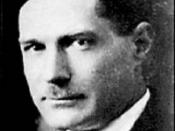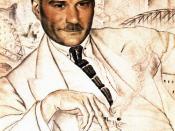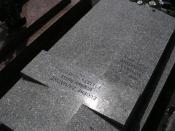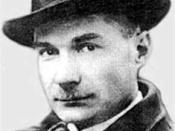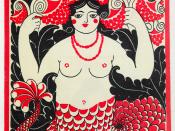Early in the 1920's Yevgeny Zamyatin wrote a story entitled We. It was a story which would go on to live in infamy. Predicting much of the horror to come during the years of Stalin, Zamyatin felt much pressure during the writing of We. Its vivid description of a society so corrupted by ideals of logic and reasoning brought much dissatisfaction from many of the high ranking political figures of the time. But nonetheless, Zamyatin stood by his book. Its perfect usage of dark humor and symbolism is what made this book as influential as it is. As an engineer, Zamyatin's writing tended to share some of his scientific impressions. His book is perfect example of how one blends one's own knowledge and experience into a story. It is through this, we can see where much of the symbolism comes from. But, being limited to a single essay one must pick out some of the finer types of symbolism.
These types of symbolism are Zamyatin's usage of mathematics, his physical descriptions of the characters and the world they live in, through his examples of character identity loss, and finally through the relationships the characters have.
As mentioned earlier, Zamyatin studied as an engineer before turning to writing. His scientific background is what helped him to breathe symbolism into his story through the usage of mathematics. For example, one of the main topics in the story is the construction, by our main character D-503, of a rocket ship called the Integral. For those unfamiliar to the concept of an integral, it is a function of calculus used to take a function to higher dimension. In the same way, this ship is to take this, so called, perfect society to the next dimension. Another example of mathematical symbolism is that of logic and reasoning. Because this society is perfectly logical it is supposedly in a state of pure happiness. But a short look at this society shows that there is a serious flaw in the reasoning used to arrive at this conclusion. This shows how a society believing to be so perfect and logical is failing due to the exact reason for which this society is believed perfect. The society is so deeply flawed that a change to the society is almost impossible. To most of the characters of this story change is an illogical concept anyway. One way this is expressed is through the nagging concept of the square root of negative one. In math this is considered an imaginary and irrational number, a concept not comfortable with our main character. To D-503, the existence of a number not rationally possible brings about feelings of doubt. This doubt scares him because it shows that perhaps his society's almighty belief in pure logic and rationality isn't entirely correct. It even shakes the basis of his intellectual existence. Finally, Zamyatin uses the mathematical symbol X throughout the book. The symbol X is used in math to represent unknown values. In a similar way, D-503 uses it to describe people's faces and demeanors. There many situations when D-503 has trouble figuring out the thoughts and feelings of another certain person by looking at her face. The face of this person, I-330, is to him like an X, an unknown for which he wants to solve. In the same way D-503 is troubled by irrationality, he begins to feel uneasy about this unknown. It brings about feelings of doubt and confusion. He dislikes not knowing what this person is thinking. The usage of the unknown value X to describe I-330's face is also an example of another type of symbolism used in this story.
The physical description of the characters and world around them is a powerful method Zamyatin uses to symbolize characters feelings as well as certain aspects of the society they live in. Just as the X was used to describe the face of I-330, the facial features of the characters are beautiful insights into their inner workings. Zamyatin sometimes describes character's faces as being round to symbolize happiness and a feeling of content. He also describes his character I-330 as having sharp teeth. This possibly is meant to allude to the biblical reference of Adam & Eve. I-330's sharp teeth could be symbolizing that she is Eve, the one who ate the apple in the Garden of Eden. Just as Eve ate the apple and brought about a complete change of life, I-330 is a revolutionary trying to bring about a change to this society. In a similar manner, the description of D-503's hands is also another form of symbolism. D-503 believes his hands have an animal like look which disturbs him. It's this animal like look that is so important. To most people of this time the people of the past were very uncivilized and animal like. D-503's hands symbolize this connection to the past, to a society long since gone. Another interesting form character symbolism is found in their names. All of the characters throughout the story have a name in the form of a letter followed by some number. It's the letter which holds some symbolism. I-330 is described as a slender woman much like that of the letter I. The character S in a similar manner is described as being a man with a curvy back and being somewhat of a secretive individual. Lastly, the society for which the characters reside requires all of its members to be clothed exactly the same. One character challenged this idea, I-330. At one point she is dressed in a yellow dress wearing make-up. This dress symbolizes her individualistic personality. She refuses to believe in conformity and stagnation. It's this that brings us to the next topic of symbolism.
Zamyatin uses many different aspects of this society to symbolize how much a loss of individual identity exists. This lack of identity is meant to purvey the feeling of an extreme communist society. No person is any different or any better than any one else. No one in this society owns anything. For instance, the requirement for the members of this society to wear the exact same thing shows how everyone is viewed as the same. In the same manner, their names force them to remain in a constant state of conformity. They all have names which follow the form of a letter followed by some number. This name restriction imposes on the society's members a harsh means of equality. Not only are there rules to control individuality through clothing and naming, but for sexual intercourse. Nothing in this society belongs to any one person. Therefore no one has a wife or husband. When it comes to the act of sex, any individual, given they are of the right age, has the right to pick any other person as their sexual partner. This concept brings about a true feeling that individualism is no longer existent. It turns an act of love between two people into an animal function used only for the continuation of a society's population. Not only is there a restriction on sex but on one's day-to-day life. There is a Table of Hours which tells what everyone should be doing at any given hour. It's another form of symbolism showing total conformity. Yet another way this society impedes on the right of individuality is through the restriction of privacy. The whole city that this society lives in is made entirely of glass. This way any one person can see what any one else is doing. The only exception is when one is permitted to lower their blinds for the act of sex. This lack of privacy symbolizes how far this society has gone to protect from individuality. The final and most extreme step taken by the society is the eventual removal of every person's imagination. This is accomplished through what is called The Great Operation. It is really just a form of mass lobotomization of the society's citizens. This symbolizes the final step in securing a hold on total conformity. For no one can be an individual if they lack an imagination. It is the basis for what makes us human.
Even with all these methods of conformity, certain people have made efforts to maintain there individuality. One attempt to do this was through the relationships that the characters of the story had with D-503. These relationships symbolized the internal need for individuality. In the early party of the story, D-503 has a sort of relationship with a woman by the name of O-90. She is frequently requesting sex from D-503 because she has feelings for him, something which is strictly forbidden. She has urges to become a mother and wants D-503 to be the father of the child. This motherly urge symbolizes O-90's need for individuality, to have her own family. Unfortunately, the society does not permit this but she attempts to have one anyway. Later on, D-503 becomes attracted to I-330's individualistic qualities and begins to have a twisted relationship with her. He begins to lust for her and want to be more like her, but he's too scared to try. His encounters with I-330 symbolize his need to break free of conformity and live a life chosen by himself and not one deemed by his society. Of course at the same time this is happening, his previous female counterpart, O-90, starts to slump back into her conformist ways. But, even then she has still changed in some respects. Her permanent change is a symbol of how individuality is something someone cannot live without. She has changed, just as D-503 did, and will never be the same. This is a true proof for the need of some individual freedoms.
Yevgeny Zamyatin's story of D-503's struggles with individuality in a society that requires total conformity is a true masterpiece. Its remarkable usage of symbolism is what makes this such an amazing work. Through his usage of mathematics, physical characteristics, identity, and the relationships throughout the story, Zamyatin paints a clear picture of society so far beyond perfection that it has reached a point of near perfect imperfection.
Bibliography Zamyatin, Yevgeny. We. Translator: Mirra Ginsburg. New York: Avon Books Inc., 1972
